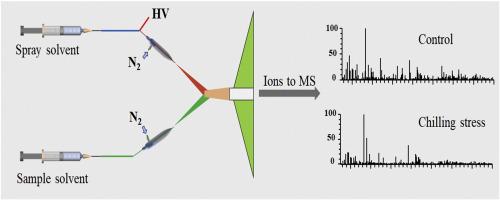当前位置:
X-MOL 学术
›
Environ. Exp. Bot.
›
论文详情
Our official English website, www.x-mol.net, welcomes your
feedback! (Note: you will need to create a separate account there.)
Metabolomic analysis of chilling response in rice (Oryza sativa L.) seedlings by extractive electrospray ionization mass spectrometry
Environmental and Experimental Botany ( IF 4.5 ) Pub Date : 2020-12-01 , DOI: 10.1016/j.envexpbot.2020.104231 Shangguang Du , Meng Cui , Yali Cai , Ahui Xue , Yingbin Hao , Xueyong Huang , Lihua Liu , Liping Luo
Environmental and Experimental Botany ( IF 4.5 ) Pub Date : 2020-12-01 , DOI: 10.1016/j.envexpbot.2020.104231 Shangguang Du , Meng Cui , Yali Cai , Ahui Xue , Yingbin Hao , Xueyong Huang , Lihua Liu , Liping Luo

|
Abstract Chilling stress is a major production threat for rice (Oryza sativa L.). The mechanism of chilling response has not been unveiled up to now, especially at the metabolomic level. In this study, two Asian rice cultivars, Qiutianxiaoting (chilling-tolerant variety) and 93−11 (chilling-susceptible variety), were used to analyze the metabolic changes when exposed to low temperature and recovered by extractive electrospray ionization mass spectrometry (EESI-MS). Physiological and metabolic analysis combining with bioinformatics were performed to reveal cold resistance mechanism of these two varieties. Physiological analysis showed that only Qiutianxiaoting survived after 36 h chilling treatment, and the growth indexes of Qiutianxiaoting took on a decreasing trend, but these indexes of 93−11 appeared a trend of increase under cold treatment; moreover, the levels of antioxidant activities (SOD, POD and CAT) were higher in Qiutianxiaoting than 93−11, especially at recovery stage. PCA and OPLS-DA analysis all showed that Qiutianxiaoting, not 93−11, could be separated with each other under chilling stress, which indicated that these two subspecies of rice had different mechanisms to resist cold temperature. The results of metabolic analysis indicated that low temperature activated phenylpropanoid biosynthesis and flavone and flavonol biosynthesis in 93−11, while it induced the expression of methyl jasmonate biosynthesis-related genes in Qiutianxiaoting, which might mitigate chilling damage and effectively make it more cold-resistant than 93−11. This study would shed some lights on the cold resistance mechanism of these two rice cultivars in terms of physiological and metabolic analysis.
中文翻译:

通过萃取电喷雾电离质谱法对水稻(Oryza sativa L.)幼苗的低温反应进行代谢组学分析
摘要 低温胁迫是水稻 (Oryza sativa L.) 的主要生产威胁。寒冷反应的机制至今尚未揭示,尤其是在代谢组学水平。本研究利用两个亚洲水稻品种秋田小亭(耐寒品种)和 93-11(耐寒品种),分析了低温下的代谢变化,并通过萃取电喷雾电离质谱(EESI-小姐)。结合生物信息学进行生理代谢分析,揭示这两个品种的抗寒机制。生理分析表明,冷处理36 h后仅秋田小亭存活,秋田小亭各项生长指标呈下降趋势,而93-11各项指标在冷处理后呈上升趋势;此外,秋田小亭的抗氧化活性(SOD、POD和CAT)水平高于93-11,尤其是在恢复阶段。PCA和OPLS-DA分析均表明,秋田小听而非93-11在低温胁迫下可以相互分离,这表明这两个亚种水稻具有不同的抗低温机制。代谢分析结果表明,低温激活了93-11的苯丙素生物合成和黄酮和黄酮醇的生物合成,同时诱导秋田小亭茉莉酸甲酯生物合成相关基因的表达,可能减轻冷害,有效提高其抗寒性。比 93−11。本研究将从生理和代谢分析方面阐明这两个水稻品种的抗寒机制。
更新日期:2020-12-01
中文翻译:

通过萃取电喷雾电离质谱法对水稻(Oryza sativa L.)幼苗的低温反应进行代谢组学分析
摘要 低温胁迫是水稻 (Oryza sativa L.) 的主要生产威胁。寒冷反应的机制至今尚未揭示,尤其是在代谢组学水平。本研究利用两个亚洲水稻品种秋田小亭(耐寒品种)和 93-11(耐寒品种),分析了低温下的代谢变化,并通过萃取电喷雾电离质谱(EESI-小姐)。结合生物信息学进行生理代谢分析,揭示这两个品种的抗寒机制。生理分析表明,冷处理36 h后仅秋田小亭存活,秋田小亭各项生长指标呈下降趋势,而93-11各项指标在冷处理后呈上升趋势;此外,秋田小亭的抗氧化活性(SOD、POD和CAT)水平高于93-11,尤其是在恢复阶段。PCA和OPLS-DA分析均表明,秋田小听而非93-11在低温胁迫下可以相互分离,这表明这两个亚种水稻具有不同的抗低温机制。代谢分析结果表明,低温激活了93-11的苯丙素生物合成和黄酮和黄酮醇的生物合成,同时诱导秋田小亭茉莉酸甲酯生物合成相关基因的表达,可能减轻冷害,有效提高其抗寒性。比 93−11。本研究将从生理和代谢分析方面阐明这两个水稻品种的抗寒机制。











































 京公网安备 11010802027423号
京公网安备 11010802027423号